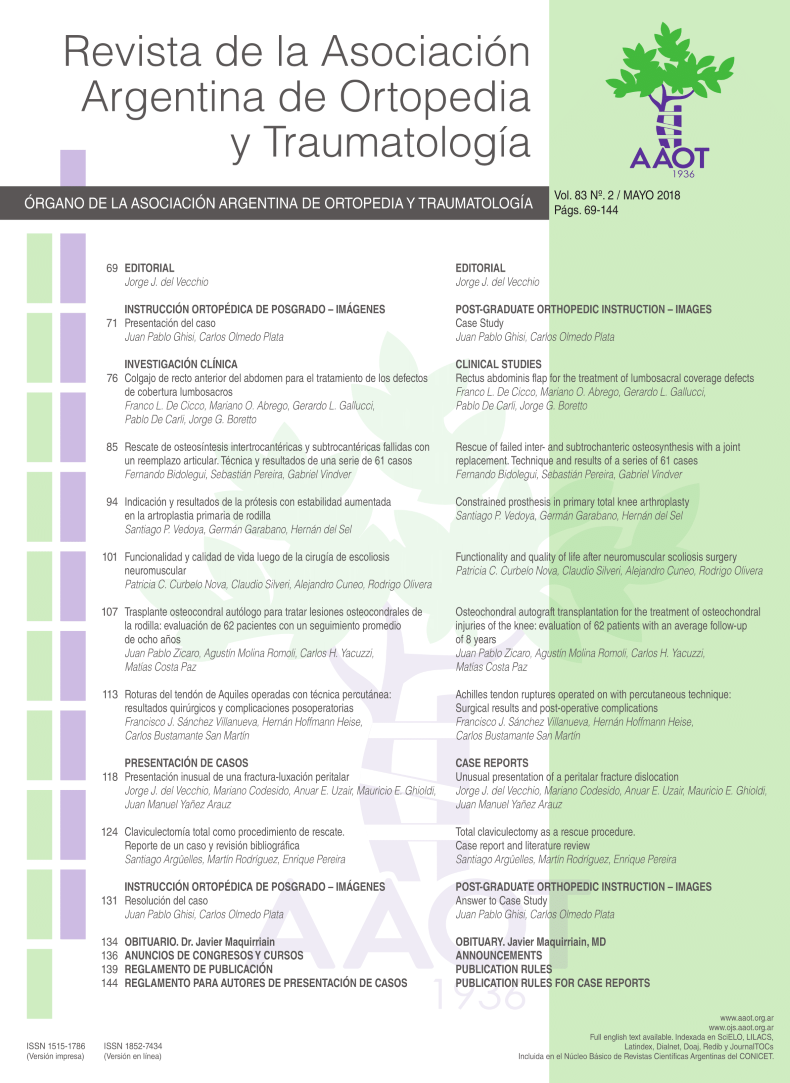Constrained prosthesis in primary total knee arthroplasty
Main Article Content
Abstract
This paper presents the functional results and indication criteria for prostheses for total knee arthroplasty with more constraint than posterior stabilization more constraint than posterior-stabilized.
Methods:
Retrospective analysis of 43 TKA in 40 patients with an average follow up of 6.2 years. The preoperative diagnoses were valgus osteoarthritis in 38 cases and varus in 5. We classified the sufficiency of the collateral ligaments as sufficient, attenuated or incompetent. We developed a classification system for the valgus Osteoarthritis, which related the type of knee with the selected prosthesis.
Results:
Posterior-stabilized plus implants were used in 28 cases, with an average alignment of 15.9°: 26 were valgus knees, 21 of which presented sufficient and 5 attenuated ligaments. Constrained prosthesis were used in 7 patients with an average valgus alignment of 21.6°, (2 with sufficient and 5 with attenuated ligaments.) Rotating-Hinge prosthesis were used in 8 patients, 5 with an average valgus alignment of 24.6 ° (3 of them associated to recurvatum), 4 with incompetent ligaments and one with attenuated ligaments.
Conclusions:
We recommend using: Posterior-stabilized plus implants in deformities lower than 20°, with sufficient collateral ligaments and no bone defects; constrained prosthesis in patients with greater deformity (>20°) with collateral ligaments with some degree of sufficiency (attenuated at the most); and rotating-hinge implants in knees with collateral or multidirectional ligament insufficiency, associated with recurvatum, significant bone defects or severe deformities in rheumatoid arthritis or neuropathic origin.
Downloads
Metrics
Article Details

This work is licensed under a Creative Commons Attribution-NonCommercial-ShareAlike 4.0 International License.
Manuscript acceptance by the Journal implies the simultaneous non-submission to any other journal or publishing house. The RAAOT is under the Licencia Creative Commnos Atribución-NoComercial-Compartir Obras Derivadas Igual 4.0 Internacional (CC-BY-NC.SA 4.0) (http://creativecommons.org/licences/by-nc-sa/4.0/deed.es). Articles can be shared, copied, distributed, modified, altered, transformed into a derivative work, executed and publicly communicated, provided a) the authors and the original publication (Journal, Publisher and URL) are mentioned, b) they are not used for commercial purposes, c) the same terms of the license are maintained.
In the event that the manuscript is approved for its next publication, the authors retain the copyright and will assign to the journal the rights of publication, edition, reproduction, distribution, exhibition and communication at a national and international level in the different databases. data, repositories and portals.
It is hereby stated that the mentioned manuscript has not been published and that it is not being printed in any other national or foreign journal.
The authors hereby accept the necessary modifications, suggested by the reviewers, in order to adapt the manuscript to the style and publication rules of this Journal.
References
2- Lachiewicz PF, Soileau ES. Results of second-generation constrained condilar prosthesis in primary total knee arthroplasty. J Arthroplasty 2011; 26-8: 1228-1231.
3- Miyasaka KC, Ranawat CS, Mullaji A. 10- to 20-year follow up of total knee arthroplasty for valgus deformities. Clin Orthop Rel Res 1997; 345: 29-37.
4- Girard J, Amzalag R. Total knee arthroplasty in valgus knees: Predictive preoperative parameters influencing a constrained design selection. Orthop Traumatol Surg Res 2009; 95: 260-266.
5- Insall JN, Dorr LD, Scott RD, Scott WN. Rationale of the Knee Society clinical rating system. Clin Orthop Relat Res. 1989; 248: 13-14.
6- Kim YH, Kim JS, Oh SW. Total knee arthroplasty in neuropathic arthropathy. J Bone Joint Surg Brit 2002; 84B: 216-221.
7- Lachiewicz PF, Soileau ES. Ten-year survival and clinical results of constrained components in primary total knee arthroplasty. J Arthroplasty 2006; 21-6: 803-808
8- Lombardi A., Berend K. Posterior-Stabilized Constrained Total Knee Arthroplasty for Complex Primary Cases. J Bone Joint Surg Am 2007; 89A: 90-102.
9- Kim YH, Kim JS. Revision Total Knee Arthroplasty with Use of a Constrained Condylar Knee Prosthesis. J Bone Joint Surg Am 2009; 91A: 1440-1447.
10- Hartford JM, Goodman SB, Schurman DJ, Knoblick G. Complex primary and revision total knee arthroplasty using the constrained condylar prosthesis: an average 5-year follow up. J Arthroplasty 1998; 13: 380-387.
11- Springer BD, Hanssen AD, Sim FH, Lewallen DG. The kinematic rotating hinge prosthesis for complex knee arthroplasty. Clin Orthop Rel Res 2001; 392: 283-291.
12- Pour AE, Parvizi J, Slenker N, Purtill JJ, Sharkey PF. Rotating hinged total knee replacement: use with caution. J Bone Joint Surg 2007; 89A: 1735-41.
13- Puloski SK, McCalden RW, MacDonald SJ, et al. Tibial post wear in posterior stabilized total knee arthroplasty: an unrecognized source of polyethylene debris. J Bone Joint Surg Am 2001; 83A: 390-395.
14- Ewald FC. The Knee Society total knee arthroplasty roentgenographic evaluation and scoring system. Clin Orthop Rel Res 1989; 248: 9-12.
15- Hernandez Vaquero D, Sandoval Garcia M. Hinged total knee arthroplasty in presence of ligamentous deficiency. Clin Orthop Relat Res 2010; 468: 1248-1253.
16- Yang JH, Yoon JR, Oh CH, Kim TS. Primary total knee arthroplasty using rotating-hinge prosthesis in severely affected knees. Knee Surg Sports Traumatol Arthrosc 2012; 20: 517-523.
17- Kowalczewski J, Marczak D, Synder M, Sibinski M. Primary rotating-hinge total knee arthroplasty: good outcomes at mid-term follow-up. J Arthroplasty 2014; 29: 1202-1206.
18- Gehrke T, Kendoff D, Haasper C. The role of hinges in primary total knee replacement. J Bone Joint Surg Brit 2014; 96B-11: 93-95.
19- Petrou G, Petrou H, Tilkeridis C, Stavrakis T, Kapetsis, Kremmidas N, Gavras M. Medium-term results with a primary cemented rotating-hinge total knee replacement. A 7 to 15 year follow-up. J Bone Joint Surg Brit 2004; 86B-6: 813-817.
20- Maynard LM, Sauber TJ, Kostopulos VK, Lavinge GS, Sewecke JJ, Sotereanos NG. Survival of primary condilar-contrained total knee arthroplasty at mínimum of 7 years. J Arthroplasty 2014; 29: 1197-1201.
21- Cottino U, Abdel M, Perry M, Mara K. Long-Term Results After Total Knee Arthroplasty with Contemporary Rotating-Hinge Prostheses. J Bone Joint Surg Am. 2017; 99: 324-30.

